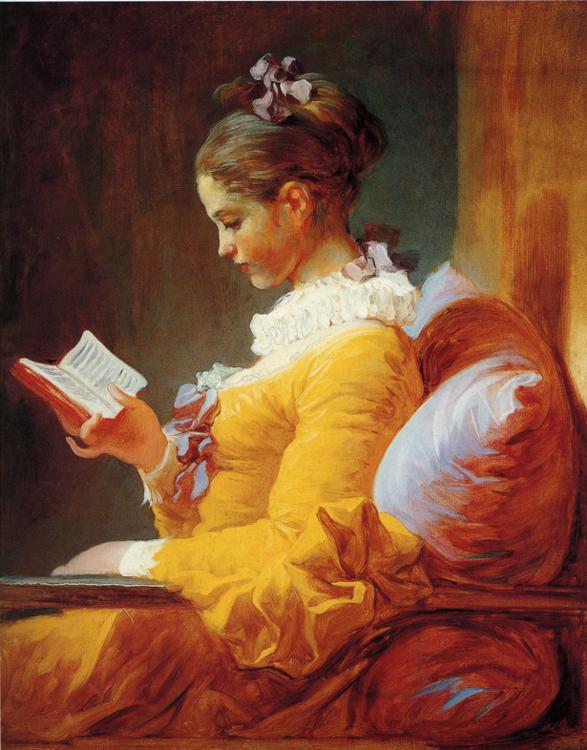
Jean-Honoré Fragonard. A Young Girl Reading. c. 1776. Oil on canvas. 81 x 65 cm. The National Gallery of Art, Washington, DC, USA
A number of times in my teaching career I have asked my students to compose a reading history. The requirements of the assignment are as follows: The students must choose five fictional or poetic works that have generated a strong emotional response, whether positive or negative. I ask that these works be spread out over time and recommend that the first be a work they encountered early, perhaps one that a parent read to them repeatedly. The students are to describe their reading experience as objectively as possible and then (here’s the tough part of the assignment) figure out who they were at the time that explains why they had the response that they had.
With regard to objectively describing the reading experience, incidentally, I ask them to describe both the “external dimensions” of the experience (how did they come across the book, where were they when they read it, etc.) and the “internal dimensions” (what characters and passages do they recall). I ask that they not look up the book until after they have described it. Memory plays tricks and what they remember is more revealing than what is actually there since discrepancies reveal what elements of the book they were focusing on. I’ve had students misremember books or even combine books, and these faulty memories, when compared with the actual texts, provide powerful windows into how they were using the works to process the world.
Sometimes I’ve asked students to find a coherent story running through their book selections—or as I have occasionally put it, how are all five books actually the same book? If they are able to find a running theme, then they have located their own “identity theme” (as Freudian critic Norman Holland calls it). A certain self is seeking out books, or processing the books that come its way, in order to articulate its needs.
Let me provide an example of such a theme, which will also show you how the reading history works at its best. I have mentioned before a biracial student of mine (half Philippine, half African American) who wrote her senior project on “The Role of Ethnicity in Reader Identification.” Along with a study she conducted of eight readers of different races and ethnicities, she recalled books that she herself had loved throughout her life and then looked for a pattern. The books she chose were Dr. Seuss’s “Cat in the Hat,” Judy Blume’s Freckle Juice, Bernard Waber’s Ira Sleeps Over, Shel Silverstein’s “The Missing Piece,” Go Ask Alice, Maya Angelou’s I Know Why The Caged Bird Sings, Alice Walker’s The Color Purple, Lucille Clifton’s The Book of Light, and Toni Morrison’s The Bluest Eye. She couldn’t explain the appearance of “Cat in the Hat” in her list but realized that the other books were either about feeling uncomfortable with an identity or stepping into an identity. The later books were specifically focused on issues of racial identity, but she realized that she had been reading her confusion about her own ethnic identity into the earlier books as well.
As I think about it, I can see how even “Cat in the Hat” fits the pattern. Eleanor identified with the fish, who is terribly disturbed when the natural order of things is upset. Eleanor wanted everything to be clear and ordered, and her journey through life involved discovering that, while her mixed race made everything confusing and uncomfortable, it actually became a source of strength once she accepted and embraced it. The works of Angelou, Clifton, and Walker showed her women of color embracing their color while Morrison’s The Bluest Eye served as an object lesson of what happens when you don’t.
I can’t recommend enough the value of writing your reading history, and I will regularly post reflections from my own. I must confess, however, that I was not able to limit myself to five books. In fact, this blog is functioning in part as an extended reading history.
And if you, dear reader, find yourself wondering why a certain book had the impact on you that it did, I would be more than willing to help guide you as you search out the reasons why. I can promise you that light will break in (to quote a Clifton poem) as you come to an understanding. Just post a comment or send me an e-mail and we’ll work together on it.


One Trackback
[…] delivered my caveat, however, I can also report that there is stuff to be found. I have spent years assigning “reading histories” to students and have found that one can almost always find a personal “identity theme” running through […]